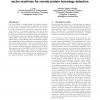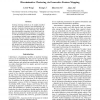439 search results - page 22 / 88 » Maximum entropy methods for biological sequence modeling |
RECOMB
2002
Springer
14 years 9 months ago
2002
Springer
One key element in understanding the molecular machinery of the cell is to understand the meaning, or function, of each protein encoded in the genome. A very successful means of i...
AAAI
2012
11 years 11 months ago
2012
Existing clustering methods can be roughly classified into two categories: generative and discriminative approaches. Generative clustering aims to explain the data and thus is ad...
IJCNLP
2005
Springer
14 years 2 months ago
2005
Springer
Biomedical named entity recognition (NER) is a difficult problem in biomedical information processing due to the widespread ambiguity of terms out of context and extensive lexical ...
BMCBI
2007
13 years 9 months ago
2007
Background: There are a number of different methods for generation of trees and algorithms for phylogenetic analysis in the study of bacterial taxonomy. Genotypic information, suc...
IDEAS
1997
IEEE
14 years 1 months ago
1997
IEEE
A variety of heterogenous data sources is available in the field of molecular biology. Our focus lies on the biological sequence data, i. e. data maintained in collections like EM...


